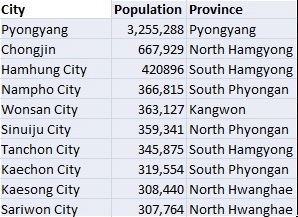According to the Hankyoreh:
According to the final report on North Korea’s 2008 census, the population of the country listed under the category of ‘sex’ is 11,721,838 men and 12,330,393 women, for a total population of 24,052,231. However, under the category of ‘region,’ the totals are 11,059,489 men and 12,290,370 women, for a total population of 23,349,859. In other words, some 702,372 people are missing from the second total.
What accounts for the difference? One clue is the fact that the total population by region omits the population residing in military camps, which is included in the population under the category of sex. Additionally, men accounted for 94.3 percent of the omitted population, or 662,349 people, while women represented just 5.7 percent, or 40,023 people. According to age, some 96.4 percent of the omitted total, or 676,737 people, were in the population aged 15 to 29. In particular, people aged 20 to 24 accounted for 57 percent, or 400,052, of the omitted number. In short, this means that men aged 15 to 29 were systematically left out of the estimates for total population by region. Seoul National University Professor Park Keong-suk, who analyzed the census results, said, “This appears to indicate an attempt by North Korean authorities, for security reasons, to avoid clear information coming to light on the distribution of population at military camps by region.”
In any event, the results of the census, which included military camps in examination, essentially confirm a population of 702,372 people residing at military camps in North Korea. Does this mean that the total scale of the North Korean People’s Army is just over 700 thousand troops? It is still too early to reach any conclusions. According to a statistic on “distribution of economically active population aged 16 and older by region,” a total of 699,020 people (425,319 men, 273,701 women) were listed as being employed in the areas of public administration, national defense and social security. These figures do not include residents at military camps, and due to a lack of detailed information, it is impossible to confirm how many of these 699,020 people are employed in the area of national defense.
Thus, while a precise determination is impossible, it can be estimated that the scale of the Korean People’s Army is 702,372 troops plus some additional, unspecified number. This differs markedly from South Korean Ministry of National Defense estimates, which put the size of North Korea’s regular army at 1.19 million people as of December 2008. In view of the fact that 27 percent of enlisted men in the South Korean military as of 2008 were noncommisioned and commissioned officers with addresses outside their bases, analysts say there are grounds for viewing the Defense Ministry’s estimates on the scale of the North Korean army as inflated.
I translated some of the data into excel so I could start playing with it. Here are the DPRK’s top ten largest cities by population:

It should be noted that the number of residents listed in Pyongyang are for the Province of Pyongyang–not just the city center.
